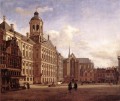Artists
Jan van der Heyden
- Country:
- Netherlands
- Birth year:
- 1637
- Death year:
- 1712
Jan Van der Heyden (1637 Gorinchem - 1712 Amsterdam) lived in Amsterdam after 1650. Until 1660, he was engaged in various study tours that certainly led him to explore the southern Netherlands and the Lower Rhine region of Germany, but probably also as far abroad as Italy and the Mediterranean. Van der Heyden was not only a painter, but also an inventor to whom Amsterdam owed its street lighting, introduced around 1670, and the development of a new kind of fire hydrant. In painting it was he, along with the Berckheyde brothers, who developed the background theme of the cityscape into an independent painting subject. Van der Heyden painted the streets and plazas of Amsterdam, Antwerp, Delft, Brussels, and other cities with a wealth of detail, although not always with topographical exactitude. His major works include View of the Herengracht in Amsterdam, c. 1680, Musee du Louvre, Paris, View of the Westerkerk of Amsterdam, c. 1680, The Wallace Collection, London, and Corner of a Room with Rare Objects, 1712, Magyaar Nemzeti Muzeum, Budapest.







